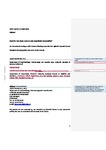Quest for new drugs: a way to solve anaesthesia neurotoxicity?
| dc.contributor.author | Vutskits, L | |
| dc.contributor.author | Sneyd, John | |
| dc.date.accessioned | 2018-04-30T15:01:19Z | |
| dc.date.issued | 2018-04 | |
| dc.identifier.issn | 0007-0912 | |
| dc.identifier.issn | 1471-6771 | |
| dc.identifier.uri | http://hdl.handle.net/10026.1/11377 | |
| dc.description | doi: 10.1016/j.bja.2018.01.024 | |
| dc.description.abstract |
All contemporary general anaesthetics have been convincingly shown to produce neurotoxic effects in at least some experimental animal models, and many of the underlying mechanisms have been identified.1 Whilst the human relevance of these observations is still under intense scrutiny, the elaboration of protective strategies along with the development of new ‘non-toxic’ anaesthetic drug regimens have been identified as rational research directions to alleviate potential neurotoxicity.2 In this edition of the British Journal of Anaesthesia, Atluri and colleagues3 report preliminary animal experiments for a novel neurosteroid hypnotic. They describe the compound as ‘safe’ in comparison to ketamine, and suggest that this new class of hypnotic represents ‘a distinct panselective T-type Ca2+ channel blocker devoid of GABAergic or NMDA antagonistic properties at hypnotically-relevant brain concentrations’ that provides a rational route of drug development that might lead to effective anaesthesia without paediatric neurotoxicity. | |
| dc.format.extent | 619-621 | |
| dc.format.medium | Print-Electronic | |
| dc.language | en | |
| dc.language.iso | en | |
| dc.publisher | Elsevier | |
| dc.subject | Anesthesia | |
| dc.subject | Brain | |
| dc.subject | Calcium Channels, T-Type | |
| dc.subject | Humans | |
| dc.subject | Neurotoxicity Syndromes | |
| dc.subject | Neurotransmitter Agents | |
| dc.title | Quest for new drugs: a way to solve anaesthesia neurotoxicity? | |
| dc.type | journal-article | |
| dc.type | Article | |
| plymouth.author-url | http://dx.doi.org/10.1016/j.bja.2018.01.024 | |
| plymouth.issue | 4 | |
| plymouth.volume | 120 | |
| plymouth.publication-status | Published | |
| plymouth.journal | British Journal of Anaesthesia | |
| dc.identifier.doi | 10.1016/j.bja.2018.01.024 | |
| plymouth.organisational-group | /Plymouth | |
| plymouth.organisational-group | /Plymouth/Faculty of Health | |
| plymouth.organisational-group | /Plymouth/Users by role | |
| dc.publisher.place | England | |
| dcterms.dateAccepted | 2018-01-29 | |
| dc.rights.embargodate | 2019-2-24 | |
| dc.identifier.eissn | 1471-6771 | |
| dc.rights.embargoperiod | Not known | |
| rioxxterms.versionofrecord | 10.1016/j.bja.2018.01.024 | |
| rioxxterms.licenseref.uri | http://www.rioxx.net/licenses/all-rights-reserved | |
| rioxxterms.licenseref.startdate | 2018-04 | |
| rioxxterms.type | Journal Article/Review |


